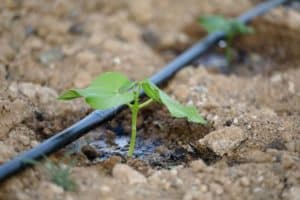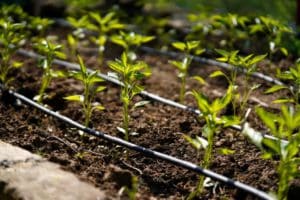If you’re a homeowner in Cleveland looking for an efficient way to keep your garden or lawn healthy, drip irrigation might be the smart solution you need. Unlike traditional sprinklers that waste water through evaporation and runoff, drip irrigation delivers moisture directly to plant roots, maximizing every drop.
As water conservation becomes increasingly important, more homeowners are turning to this efficient, low-maintenance system to save time, money, and resources, all while keeping their landscape lush and thriving. That said, what is drip irrigation, and how does it work?
How Drip Irrigation Works

Drip irrigation systems use a network of flexible tubing, small emitters, and connectors to deliver a steady, slow flow of water directly to the root zone of plants. The emitters are placed strategically near each plant, releasing water at a controlled rate, usually between 0.5 to 4 gallons per hour. This method prevents oversaturation and ensures the soil remains consistently moist without waste.
The system can be attached to a standard outdoor faucet or integrated with an existing sprinkler system for added convenience. Many homeowners also install timers or smart controllers to automate watering schedules, making it a “set it and forget it” solution for busy lifestyles.
Best Uses: What Is Drip Irrigation Good For?

Drip irrigation is ideal for many types of landscapes, but it shines in certain applications where precision watering is key. Here are some of the best uses:
- Garden beds: Keep flowers, vegetables, and herbs evenly watered without wetting the foliage. This helps prevent fungal diseases and promotes healthier, more vibrant growth.
- Trees and shrubs: Provides deep, targeted watering for larger root systems. It encourages stronger root development and reduces the need for frequent watering.
- Sloped or uneven areas: Reduce water runoff and erosion by delivering water slowly. This ensures moisture stays where it’s needed instead of washing away.
- Container plants: Perfect for patios or small spaces where overwatering can quickly occur. A drip setup makes it easy to maintain consistent moisture without daily watering.
- Water-restricted areas: Great for regions with water conservation laws or frequent droughts. It allows homeowners to maintain beautiful landscaping while staying compliant with local regulations.
By customizing the layout and flow rate, homeowners can design systems that suit their exact garden needs, from vegetable patches to ornamental flower beds.
Pros and Cons of Drip Irrigation
Pros:
- Water and cost savings: Drip irrigation uses up to 50% less water than traditional sprinklers by targeting roots directly.
- Healthier plants: Consistent moisture promotes stronger, deeper root growth.
- Prevents disease: Because it waters the soil — not the leaves — it reduces moisture-related plant diseases.
- Low-pressure friendly: Works efficiently even in areas with limited water pressure.
- Automation options: Can be connected to timers or smart controllers for easy scheduling.
Cons:
- Clogging issues: Emitters may clog over time due to dirt, debris, or mineral buildup.
- Maintenance required: Regular inspections are needed to ensure emitters aren’t blocked or buried.
- Vulnerability: Tubing can be damaged during routine yard work like trimming or digging.
- Initial setup time: Installation requires planning and occasional adjustments as plants grow.
Despite these minor drawbacks, proper maintenance can easily keep a drip system running efficiently for years.
Cost and Installation Overview
The cost of drip irrigation depends on the size of your yard and whether you install it yourself or hire a professional. On average, homeowners in Cleveland can expect the following:
- DIY installation: Around $0.50–$1.50 per square foot, depending on materials. This is a great option for small gardens or homeowners who enjoy hands-on projects and want to save on labor costs.
- Professional installation: Around $1.50–$4.00 per square foot, including labor. Hiring an expert ensures proper layout, pressure regulation, and system efficiency from day one.
- Maintenance costs: Minimal — usually limited to seasonal cleaning and occasional emitter replacement. With regular care, a drip irrigation system can last for many years with little ongoing expense.
Conclusion
Drip irrigation offers a smart, sustainable way to keep your Cleveland landscape healthy while conserving water. By delivering moisture directly to the roots, it minimizes waste, prevents plant stress, and supports lush growth even in challenging weather conditions. Though it requires occasional upkeep, the long-term savings in water and maintenance make it a worthwhile investment.
Whether you’re maintaining a small garden or a full backyard landscape, drip irrigation provides efficiency, convenience, and peace of mind all year long.
